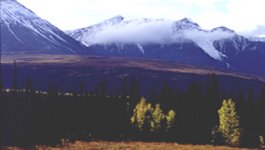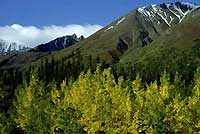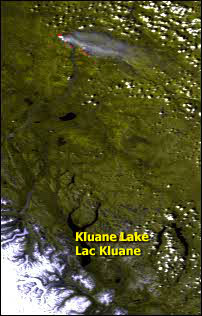Yukon

Auriol Trailhead Kluane National Park

Autumn colours in the Kluane Range.
© Parks Canada /S. Osbourne/ yfu/knpr
 Yukon Territories
Yukon Territories
| On March 14,
2010 the Eastern Native Tree Society and Western Native Tree
Society switched from discussion lists on Google Groups to a new
discussion list in a Bulletin Board format at:
http://www.ents-bbs.org/index.php
Posts made since the inception of the BBS on March 14, 2010 will
be sorted and archived on the BBS. Click on the link to go to
the equivalent section on the new BBS. This website will
continue to serve as a front end for the ENTS and WNTS groups.
It will continue to serve as a repository of older posts, and
will serve as the host site for special projects and features
that are not well suited for a BBS format. Please visit the BBS
for the latest information and trip reports. |
Field Trips and Discussions
 Kluane National
Park and Preserve, Yukon Territories, Canada http://www.pc.gc.ca/pn-np/yt/kluane/index_e.asp
A gem in the family of Parks Canada's national treasures, Kluane National Park and Reserve of Canada covers an area of 21,980 square kilometres. It is a land of precipitous, high mountains, immense icefields and lush valleys that yield a diverse array of plant and wildlife species and provides for a host of outdoor activities. Kluane National Park and Reserve is also home to Mount Logan (5959 m/19,545 ft), Canada's highest peak.
The climatic overlap of the pacific and arctic air masses over Kluane
National Park & Reserve has resulted in one of the greatest
diversity of plants and wildlife in northern Canada. A montane forest of
white spruce, trembling aspen and balsam poplar covers much of the lower
valleys and slopes. Treeline is at 1050 to 1200 m (3,500 to 4,000'),
depending upon local conditions. Low-growing or stunted shrubs in the
transition zone include: willow, dwarf birch, and alder, which provide
protection for the smaller plants. Summers in alpine tundra (generally
above 1400 m or 4600') are a flourish of colour, with over 200 varieties
of alpine flora. Kluane National
Park and Preserve, Yukon Territories, Canada http://www.pc.gc.ca/pn-np/yt/kluane/index_e.asp
A gem in the family of Parks Canada's national treasures, Kluane National Park and Reserve of Canada covers an area of 21,980 square kilometres. It is a land of precipitous, high mountains, immense icefields and lush valleys that yield a diverse array of plant and wildlife species and provides for a host of outdoor activities. Kluane National Park and Reserve is also home to Mount Logan (5959 m/19,545 ft), Canada's highest peak.
The climatic overlap of the pacific and arctic air masses over Kluane
National Park & Reserve has resulted in one of the greatest
diversity of plants and wildlife in northern Canada. A montane forest of
white spruce, trembling aspen and balsam poplar covers much of the lower
valleys and slopes. Treeline is at 1050 to 1200 m (3,500 to 4,000'),
depending upon local conditions. Low-growing or stunted shrubs in the
transition zone include: willow, dwarf birch, and alder, which provide
protection for the smaller plants. Summers in alpine tundra (generally
above 1400 m or 4600') are a flourish of colour, with over 200 varieties
of alpine flora.

Kluane Lake, Yukon Forest Fires NOAA Images - June 01, 1998 http://www.ccrs.nrcan.gc.ca/ccrs/rd/apps/forest/yukfire/yukfire_e.html
 Yukon Forest Protection
Regulations http://www.canlii.org/ca/regu/sor87-531/
Yukon Forest Protection
Regulations http://www.canlii.org/ca/regu/sor87-531/
 Arctic Borderlands Ecological Knowledge Co-op
- Yukon Forest Fires http://www.taiga.net/coop/indics/fire.html
Information on the number and sizes of forest fires in the Northern
Yukon has been gathered by the Forestry Branch of the Department of
Indian Affairs and Northern Development. Data have been collected since
1946, providing a 50-year record of forest fire occurrence. Maps
of the total numbers of recorded forest fires that have occurred in the
North Yukon between 1946 and 1992 (above) show that the number of fires
in this area has not been many. However, forest fires in the Northern
Yukon are generally large in size, and a given area in the North Yukon
forest is expected to burn once about every 50 years.
Arctic Borderlands Ecological Knowledge Co-op
- Yukon Forest Fires http://www.taiga.net/coop/indics/fire.html
Information on the number and sizes of forest fires in the Northern
Yukon has been gathered by the Forestry Branch of the Department of
Indian Affairs and Northern Development. Data have been collected since
1946, providing a 50-year record of forest fire occurrence. Maps
of the total numbers of recorded forest fires that have occurred in the
North Yukon between 1946 and 1992 (above) show that the number of fires
in this area has not been many. However, forest fires in the Northern
Yukon are generally large in size, and a given area in the North Yukon
forest is expected to burn once about every 50 years.
 Yukon Forest
Industry Association http://www.ainc-inac.gc.ca/nr/prs/m-a2002/for006_e.html
Of all the groups involved in the forestry issue, I spent by far the greatest share of time, in meetings and by telephone, with members of the Yukon Forest Industry Association (YFIA). This reflected my desire to gain the best possible picture of the industry's present and future role in the Yukon forest economy, and the industrial opportunities and impediments. Yukon Forest
Industry Association http://www.ainc-inac.gc.ca/nr/prs/m-a2002/for006_e.html
Of all the groups involved in the forestry issue, I spent by far the greatest share of time, in meetings and by telephone, with members of the Yukon Forest Industry Association (YFIA). This reflected my desire to gain the best possible picture of the industry's present and future role in the Yukon forest economy, and the industrial opportunities and impediments.
 Aspen clones take
the size prize http://www.taiga.net/yourYukon/col373.html Aspen clones take
the size prize http://www.taiga.net/yourYukon/col373.html
|